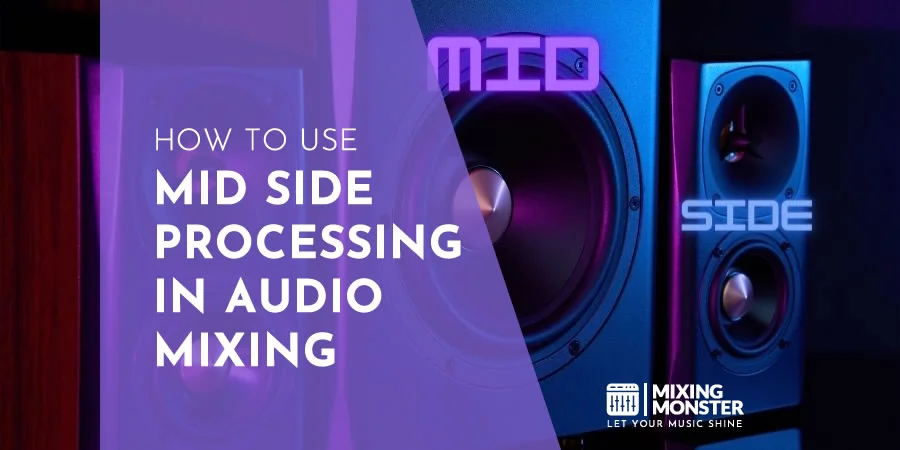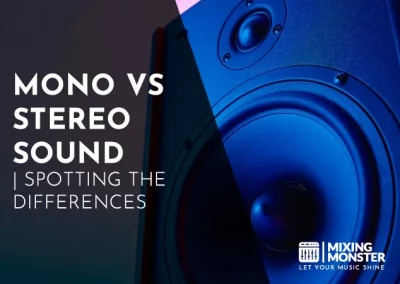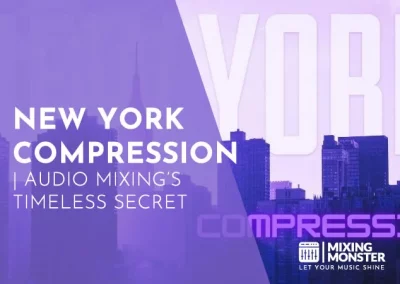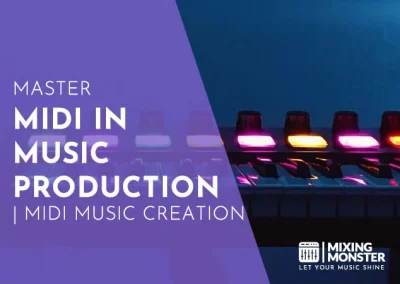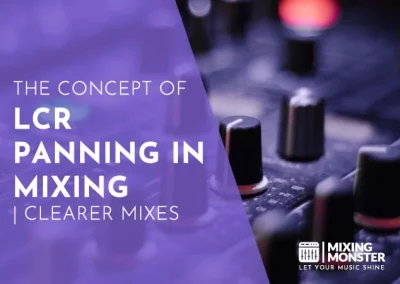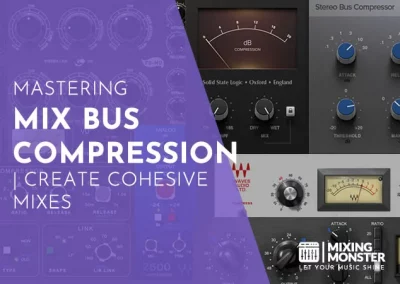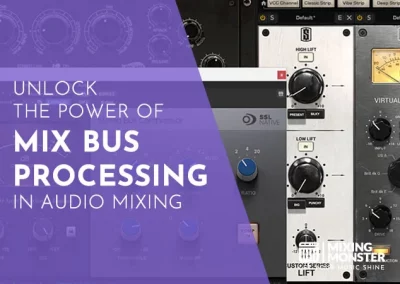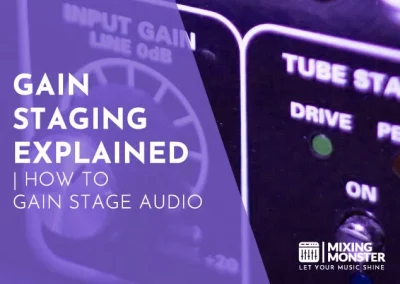Home > Blog > Mixing > Mixing Techniques
Disclosure: Some of the links below are affiliate links, meaning that at no additional cost to you, we will receive a commission if you click through and make a purchase. Read our full affiliate disclosure here.
Mid side processing is one of the cornerstones of mixing and mastering in modern music production. It’s a technique that dramatically alters and improves the stereo image and contributes to a deeper, more cohesive sound.
Mid side processing involves splitting a stereo signal into two separate channels: the mid, which contains the center content, and the side, which includes the stereo difference information. This enables engineers to manipulate the center independently and stereo spread of a mix, giving more control over the balance and placement of instruments within the soundstage.
This method can enhance clarity, define spatial details, and tailor the sonic landscape to fit the artistic vision. By delving further into this article, you’ll gain a comprehensive understanding of the technical aspects of mid side processing and how to employ this technique in your mixing and mastering workflow.
KEY TAKEAWAYS:
- Mid side processing allows independent control of a mix’s center and stereo elements.
- It helps enhance clarity and define spatial details in audio production.
- Understanding this technique is essential for achieving professional mixing and mastering results.
Table Of Contents
1. What Is Mid Side Processing?
2. Technical Aspects Of Mid Side Processing
3. Practical Mid Side Mixing Techniques
4. Advanced Mid Side Processing
5. Hardware And Software For Mid Side Processing
6. Wrapping Up Mid Side Processing
7. FAQ

1. What Is Mid Side Processing?
As you delve into audio production, mid-Side Processing emerges as a pivotal technique for manipulating stereo sound to enhance clarity and spatial quality in your mixes.
Overview Of Mid Side Processing In Audio Engineering
Mid Side processing, a concept attributed to the pioneering work of Alan Blumlein, an EMI engineer, is a strategy to manage your stereo image by encoding a standard left/right stereo track into two separate channels: mid and side.
This technique preserves mono compatibility and gives you distinct control over the center and sides of the stereo field. It’s a sound matrix with a mono (mid) component, representing the center of the stereo field that is identical in both the left and right channels and a stereo (side) component, encapsulating their differences.
Understanding Mid Channel And Side Channels
The mid channel is where the bulk of your sound resides, including vocals, snare drums, bass, and any other elements you want to be anchored in the center of your mix. Think of the mid channel as the ‘heart’ of your track – consistent and clear.
The side channel, in contrast, carries the unique elements that reside in the left and right extremes, contributing to the perceived width of the stereo image. Instruments panned to the sides, ambient recordings, and stereo effects typically populate this realm.
This dual control system affords you the precision to enhance or minimize certain aspects of the sound, sculpting a more dimensional and enveloping audio experience.
2. Technical Aspects Of Mid Side Processing
Understanding Mid Side processing allows you to manipulate stereo information precisely. By addressing the mid and side signals independently with tailored EQ and compression, you can open up new dimensions in your mix and ensure each element sits nicely in the stereo field.
Mid Side EQ And Compression
Mid Side EQ lets you adjust the midchannel and side signal frequencies separately. You might apply EQ to bring clarity or presence to the midchannel, representing the center of your stereo image and often containing vocals or kick drums. On the side signals, you may boost the high-end to enrich stereo width, creating an expansive feel.
When using compression in Mid Side processing, you can apply different compression levels to the mid and side channels. Your mid signal may require subtle compression to maintain focus. At the same time, the side channels could be compressed more to control the dynamics of stereo information, helping to achieve a balanced, well-defined mix.
Mid Side Encoding And Decoding
Mid Side encoding transforms the standard left/right stereo signal into a sum/difference representation. The mid signal is the sum of left and right channels (equally present in both), while the side signal represents the difference, containing only the audio that differs between channels.
For Mid Side decoding, the process is reversed, converting the mid and side information back into the traditional stereo perspective. Plugins that handle this encoding and decoding can be an essential part of your toolkit, enabling you to access and modify these elements precisely.
Mastering these techniques allows you to use mid side EQ and compression to fine-tune your mix and effectively utilize encoding/decoding processes to manipulate audio within the stereo field.
3. Practical Mid Side Mixing Techniques
In this section, you’ll discover specific techniques for using mid side processing to bring clarity and dimension to your mixes. The focus is on three key areas where this approach can be particularly effective: vocals, instruments, and the overall stereo width and depth.
Applying Mid Side Processing To Vocals
Mid side processing allows you to treat your vocal tracks’ mono (mid) and stereo (side) components differently. For vocals that sit prominently in the mix, consider the following table for strategic EQ and compression:
| Frequency Range | Mid Channel Treatment | Side Channel Treatment |
|---|---|---|
| Low Frequencies | High-pass filter to remove rumble | — |
| Mid Frequencies | Boost to enhance clarity | Cut slightly to avoid masking |
| High Frequencies | Gentle boost for presence | Compress subtly for sparkle |
By EQ’ing the mid and side channels with these considerations, you can ensure that your vocals have both presence and blend well with the rest of the mix without infringing on the stereo image created by other instruments.
Applying Mid Side Processing To Instruments
For instruments such as guitars, pads, snares, and cymbals, mid side processing can differentiate the sound in the stereo field. Below is a table with some suggested moves:
| Instrument | Mid Channel Treatment | Side Channel Treatment |
|---|---|---|
| Guitars | Slight compression for consistency | EQ to enhance stereo spread |
| Pads | EQ to sit comfortably under vocals | Light reverb for spatial depth |
| Snares | Boost fundamental frequencies | Subtle stereo delays or widening |
| Cymbals | Cut low frequencies to reduce mud | High shelf boost for shimmer |
Adjusting levels and frequencies in these ways can help preserve the natural dynamics of the instruments while ensuring they occupy their own space in the mix without clashing.
Enhancing Stereo Width And Depth With Mid Side Processing
Mid side processing is invaluable for manipulating the stereo image of your mix. Here’s how you can achieve a more expansive sound:
| Desired Effect | Mid Channel Treatment | Side Channel Treatment |
|---|---|---|
| Increase Stereo Width | Keep dynamics consistent | Apply stereo widening effects |
| Enhance Depth | Maintain clear bass focus | Use reverb or delay on higher frequencies |
| Balanced Frequency Distribution | Check for mono compatibility | Adjust EQ for a wider stereo feel |
By judiciously applying processing to the mid and side channels, you can increase the perception of width and depth, giving your mix a more polished and three-dimensional feel. Remember to pan your elements thoughtfully to strengthen the stereo image further.
4. Advanced Mid Side Processing
This section focuses on enhancing your mix’s stereo image and depth using specific advanced mid-side techniques. You’ll see how these methods can be applied during mixing and mastering to shape your track’s sonic palette.
Frequency-Based Mid Side Width Manipulation
When you manipulate width in the mid/side domain, it’s essential to be mindful of frequency ranges. For instance, applying a high-pass filter to the side signal can clean up the low end, preventing muddiness.
Similarly, a low-pass filter may help tame harshness in the highs. Utilizing multiband compression on the side signal allows you to control the dynamic range of specific frequency bands, ensuring that the spatial expansion feels natural.
It’s all about strategically adjusting the stereo signal to create the desired spectrum and depth without compromising the mix’s integrity.
Utilizing Mid Side Techniques For Mastering
Mastering is the final touch-up on your track, and mid/side processing here can make a difference. Mastering tools like Ozone 11 provide advanced frequency-specific mid/side processing functionalities.
With these tools, you can apply subtle touches to the mid channel to ensure vocals and key instruments sit well in the mix while delicately using expansion and widening effects on the sides to give the track a larger-than-life feel. Listen critically and adjust slowly; even minor tweaks can significantly impact you.

5. Hardware And Software For Mid Side Processing
Mastering mid side processing requires the right tools to manipulate your stereo field effectively. Whether you are searching for software plugins or hardware units, understanding your options and how they apply to different aspects of the process will significantly enhance your audio work.
Choosing The Right Mid Side Plugins
When choosing mids ide plugins, focus on ones that offer precision and control. Ideal plugins allow you to adjust the mid and side signals separately and visually represent the stereo field.
For EQing, a plugin like FabFilter Pro-Q 3 provides intuitive mid-side options. Meanwhile, for spatial effects, plugins such as Waves S1 Stereo Imager or Ozone Imager offer detailed control over the stereo spread.
Mid Side Processing In DAWs
Your Digital Audio Workstation (DAW) most likely has built-in tools for mid-side processing. For instance, Ableton users can utilize the “Utility” device to adjust mid side balance.
They can also chain it with EQ Eight for precise EQing in mid side mode. Setting up a mid-side matrix manually in your DAW enables you to apply effects like chorus, delay, and reverb independently to mid- or side channels.
Analog Vs Digital Mid Side Tools
Lastly, considering analog versus digital mid side tools is crucial. Hardware units, such as a mid side capable mixing console or outboard gear, can shape sound with a distinctive warmth and character.
However, they may require a specific microphone technique with a cardioid mic, for example. In contrast, digital tools provide flexibility and recallability, catering to endless creative possibilities without investing in expensive hardware.
When deciding between the two, consider your workflow preferences, budget, and the specific qualities you want to impart to your mixes.
6. Wrapping Up Mid Side Processing
Mid Side processing plays a crucial role in refining your audio mix. By engaging with this technique, you have the potential to achieve a mix that stands out for its clarity and spatial dynamics.
Key Takeaways For Mid Side Processing:
- Understanding M/S:
Recognize Mid Side processing as a tool for manipulating the middle (mono) and side (stereo) content separately. - Stereo Width Control:
Use Mid Side EQ to tweak the stereo width, enhancing or narrowing the spatial feel of the mix. - Center Focus:
Apply Mid Side compression to solidify the center of your stereo image, often carving space for vocals and lead instruments. - Side Enhancements:
Mid Side processing allows for detailed side adjustments, bringing life and airiness to peripheral elements without cluttering the mix.
Embrace these techniques to elevate your mixing and mastering skills. The power of Mid Side processing lies in its ability to add depth and dimension to your stereo field.
However, use it judiciously to maintain balance and coherence in your final product. Mid side processing will become an indispensable part of your audio engineering toolkit with practice.
Happy Mid Side processing!
7. FAQ
1) What are the benefits of using mid side processing in mixing?
Mid side processing allows you to manipulate your mix’s center content and stereo spread separately. This gives you the power to enhance spatial definition and focus on specific elements without affecting the rest of your track.
2) How do you set up a mid side microphone configuration?
A mid side microphone configuration typically involves placing a cardioid microphone facing the sound source (mid) and a bidirectional microphone oriented perpendicular to it (side). This setup captures both the direct sound and the ambient reflections, providing a versatile stereo image during recording.
3) In what situations is mid side EQ most effectively applied?
Mid side EQ can be most effectively applied when you aim to clarify the vocal region or control the stereo spread of specific frequencies without altering the overall balance. It’s particularly helpful for emphasizing or attenuating elements in a mix’s center or sides.
4) Can you explain the differences between mid side processing in software versus hardware?
Mid side processing can be achieved through hardware and software, with software solutions offering more flexibility and recallability. Meanwhile, hardware may impart a distinctive sonic character but is often limited by physical controls and connectivity.
5) How does mid side processing influence mastering?
Mid side processing during mastering can significantly influence the final sound by controlling width, depth, and mono compatibility. It allows fine control over the stereo field, making the master more spatially enhanced and balanced across different playback systems.
6) What techniques are involved in adjusting the mid side balance?
Adjusting the mid side balance involves techniques such as selective EQ, compression, or adding effects to either the mid or side channels. You can craft a more focused or expansive stereo image by altering the mid and side content’s relative levels and tonal balance.

